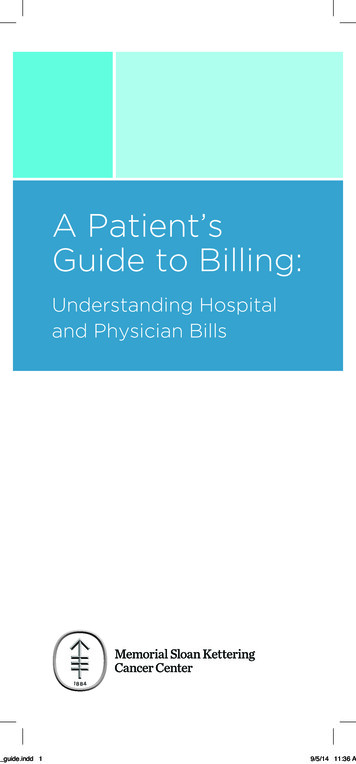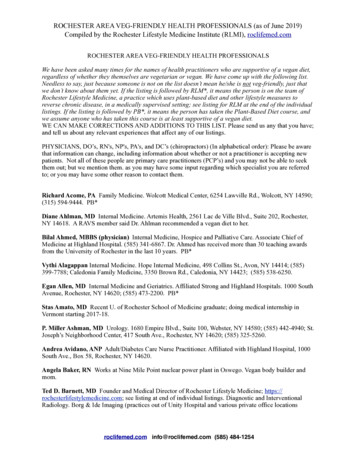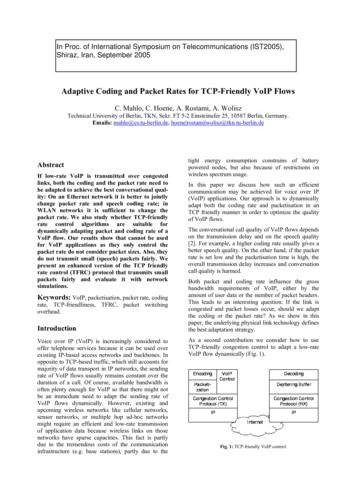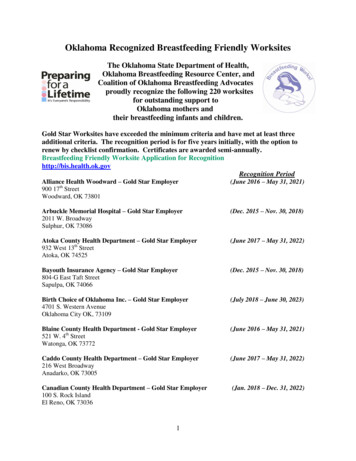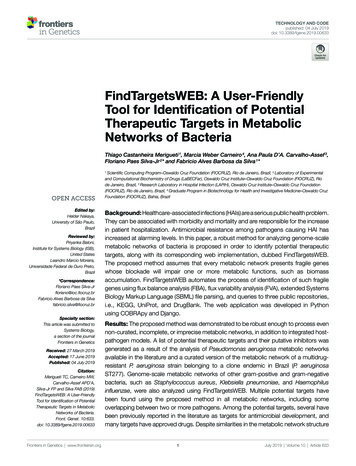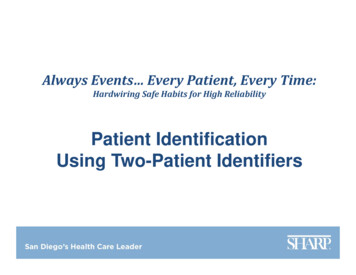
Transcription
PATIENT FRIENDLY BILLING PATIENT GLOSSARY OF BILLING TERMSTo the Provider:The PATIENT FRIENDLY BILLING Project is a nationwide initiative to make financialcommunications to patients clear, concise, and correct. The Healthcare Financial ManagementAssociation (HFMA) leads the initiative, in partnership with the American Hospital Association(AHA), the Medical Group Management Association (MGMA), and other leading provider andconsulting organizations.The PATIENT FRIENDLY BILLING project designed this glossary to be used as a guide tocommonly used terms for financial communication with patients and consumers. The terms weregathered from several sources, including hospital bills and statements. The terms then weredefined using common language that most patients would understand. Special care was taken toexclude jargon that the industry may use but that patients rarely understand. These terms werethen reviewed and revised to increase readability by many industry professionals and readingspecialist and consultant Mark Hochhauser, Ph.D.The guide can be printed as a multi-page document or be placed online as a web page. Individualterms can be placed on the back of a bill or statement, as hypertext on a web page, or as adocument to distribute. These terms are an excellent source of information for creating callscripts and training customer support staff or anyone who has contact with patients aboutfinancial matters.Members of the project hope that all providers and insurance companies start to use these termsand definitions when communicating with patients. Further initiatives are underway to includeterms used on Explanation of Benefits and insurance cards used by insurance companyorganizations.The PATIENT FRIENDLY BILLING project invites comments to this version of the glossary.The glossary is planned for release in June of 2003, and will be updated yearly. If you have anysuggestions, changes, additions, or clarifications, please send an email to Jeff Shutak, CHFP,jshutak@tmhf.org with the subject line “glossary.”Project sponsors also are seeking the endorsement of this glossary from industry associations andgroups. If you or your organizations are interested in endorsing the glossary or lending yoursupport to the PATIENT FRIENDLY BILLING project, please contact Suzanne Lestina atslestina@hfma.org.June 20, 2003NOTE: An asterisk (*) after a term means that this definition, in whole or in part, is takenfrom the Medicare Glossary, http://www.medicare.gov, February 20031
PATIENT FRIENDLY BILLING PATIENT GLOSSARY OF BILLING TERMSPATIENT FRIENDLY BILLING —Helping You UnderstandYour Healthcare BillsHow this glossary can help you.The PATIENT FRIENDLY BILLING project, working with other healthcare groups, hasproduced this booklet to help you understand many of the words on your healthcare bills andstatements. By explaining the terms on your bill and statements, this booklet will also help youunderstand how to pay your bill and statements.Do your healthcare bills confuse you?Government and state laws require doctors, hospitals, ambulance services, therapists, and othercaregivers to use different bill forms and sometimes-different terms for treatment. You mayreceive a lot of paper after a doctor or hospital visit, and may be confused by these bills and thewords on them.This booklet also includes a sample of a typical bill. Printed on the sample bill are notesexplaining what different areas of the bill mean. We have also included some questions thatpatients often ask their doctors or hospitals about their bills, and answers to those questions.There is also a page that you can use to write notes or questions to ask your doctor or hospitalabout your bill. This glossary is not a legal document.You Can HelpWe hope this booklet helps you. If you'd like to help us improve this booklet, please send us yourideas by going to the Patient Friendly Billing site at http://www.patientfriendlybilling.org orwriting us at Patient Friendly Billing, c/o HFMA, Two Westbrook Corporate Center, Ste. 700,Westchester, IL 60154.June 20, 2003NOTE: An asterisk (*) after a term means that this definition, in whole or in part, is takenfrom the Medicare Glossary, http://www.medicare.gov, February 20032
PATIENT FRIENDLY BILLING PATIENT GLOSSARY OF BILLING TERMSPATIENT GLOSSARYOFHEALTHCARE BILLING TERMSAAccount- Your charges for a medical visit.Account Number- Number you’re given by your doctor or hospital for a medical visit.Actual Charge- The amount of money a doctor or supplier charges for a certain medical serviceor supply. This amount is often more than the amount an insurance plan approves. *Adjustment- The portion of your bill that your doctor or hospital has agreed not to charge you.Admission Date (Admit Date)- Date you were admitted for treatment.Admission Hour- Hour when you were admitted for inpatient or outpatient care.Admitting Diagnosis- Words that your doctor uses to describe your conditionAdvance Beneficiary Notice (ABN)- A notice the hospital or doctor gives you before you’retreated, telling you that Medicare will not pay for some treatment or services. The notice is givento you so that you may decide whether to have the treatment and how to pay for it.Advance Directive (Healthcare)- Written ahead of time, a health care advance directive is awritten document that says how you want medical decisions to be made if you lose the ability tomake decisions for yourself. A health care advance directive may include a Living Will and aDurable Power of Attorney for health care.*All-inclusive Rate- Payment covering all services during your hospital stay.Ambulatory Payment Classifications (APC)- A Medicare payment system that classifiesoutpatient services so Medicare can pay all hospitals the same amount.Ambulatory Care- All types of health services that do not require an overnight hospital stay.*Ambulatory Surgery- Outpatient surgery or surgery that does not require an overnight hospitalstay.Amount Charged- how much your doctor or hospital bills you.Amount Paid-The dollar amount that you paid for your doctor or hospital visit.Amount Not Covered- What your insurance company does not pay. It includes deductibles, coinsurances, and charges for non-covered services.Amount Payable by Plan- How much your insurer pays for your treatment, minus anydeductibles, coinsurance, or charges for non-covered services.Ancillary Service- Services you need beyond room and board charges, such as laboratory tests,therapy, surgery and the like.Anesthesia- Drugs given to you during surgery to eliminate or reduce surgical procedure pain.June 20, 2003NOTE: An asterisk (*) after a term means that this definition, in whole or in part, is takenfrom the Medicare Glossary, http://www.medicare.gov, February 20033
PATIENT FRIENDLY BILLING PATIENT GLOSSARY OF BILLING TERMSAppeal- A process by which you, your doctor, or your hospital can object to your health planwhen you disagree with the health plan’s decision to not pay for your care.Applied to Deductible- Portion of your bill, as defined by your insurance company, that you owe yourdoctor or hospital.Assignment- An agreement you sign that allows your insurance to pay the doctor or hospitaldirectly.Assignment of Benefits- When insurance payments are sent directly to your doctor or hospital.Attending Physician Name- The doctor who certifies that you need treatment and is responsiblefor your care.Authorization Number- A number stating that your treatment has been approved by yourinsurance plan. Also called a Certification Number or Prior-Authorization Number.BBalance Bill- How much doctors and hospitals charge you after your health plan, insurancecompany, or Medicare have paid its approved amount.Beneficiary- Person covered by health insurance.Beneficiary Eligibility Verification- A way for doctors and hospitals to get information aboutwhether you have insurance coverage.Beneficiary Liability- A statement that you are responsible for some treatments or charges.Benefit - The amount your insurance company pays for medical services.Bill/Invoice/Statement- Printed summary of your medical bill.CCardiology Charges- Charges for heart procedures. Examples are heart catheterization andstress testing.Case Management- A way to help you get the care you need, especially when you need preauthorized care from several services. Usually a nurse helps arrange for your care.Centers for Medicare and Medicaid (CMS)- The federal agency that runs the Medicareprogram. In addition, CMS works with the States to run the Medicaid program. CMS works tomake sure that the beneficiaries in these programs are able to get high quality health care.*CHAMPUS- Insurance linked to military service, also know as TriCare.Charity Care- Free or reduced-fee care for patients who have financial hardship.Claim- Your medical bill that is sent to an insurance company for processing.Claim Number- A number given to a medical service.Clean Claim- A claim that does not have to be investigated by insurance companies before theyprocess it.Clinic- An area in a hospital or separate building that treats regularly scheduled or walk-inpatients for non-emergency care.COBRA Insurance- Health insurance that you can buy when you lose your job. It is generallyJune 20, 2003NOTE: An asterisk (*) after a term means that this definition, in whole or in part, is takenfrom the Medicare Glossary, http://www.medicare.gov, February 20034
PATIENT FRIENDLY BILLING PATIENT GLOSSARY OF BILLING TERMSmore expensive than insurance provided through your job but less expensive than insurancepurchased on your own when you are unemployed.Coding of Claims- Translating diagnoses and procedures in your medical record into numbersthat computers can understand.Coinsurance- The cost sharing part of your bill that you have to pay.Coinsurance Days (Medicare)- Hospital Inpatient Medicare coverage from day 61 to day 90 ofcontinuous hospitalization. You are responsible for paying for part of those days. After the 90thday, you enter your "Lifetime Reserve Days."Collection Agency- A business that collects money for unpaid bills.Consent (for treatment)- An agreement you sign that gives your permission to receive medicalservices or treatment from doctors or hospitals.Contractual Adjustment- A part of your bill that your doctor or hospital must write off (notcharge you) because of billing agreements with your insurance company.Coordination of Benefits (COB)- A way to decide which insurance company is responsible forpayment if you have more than one insurance plan.Co-payment- A cost sharing part of your bill that is your responsibility to pay. Also known asco-pay.Coronary Care- Routine charges for care you receive in a heart center because you need morecare than you can get in a regular medical unit.Covered Benefit- A health service or item that is included in your health plan, and that is paidfor either partially or fully.*Covered Days- Days that your insurance company pays for in full or in part.CPT Codes- A coding system used to describe what treatment or services were given to you byyour doctor.CT Scan- A type of X-ray of the head or body; usually done in a hospital’s x-ray department.DDate of Bill- The date the bill for your services is prepared. It is not the same as the date ofservice.Date of Service (DOS)- The date(s) when you were treated.Days- The total number of days that you are being charged for the hospital’s services.Deductible- How much cost sharing that you must pay for medical services often before yourinsurance company starts to pay.Description of Services- Tells what your doctor or hospital did for you.Diagnosis Code- A code used for billing that describes your illness.Diagnosis-Related Groups (DRGs) - A payment system for hospital bills. This systemcategorizes illnesses and medical procedures into groups for which hospitals are paid a fixedamount for each admission.Discharge Hour- Hour when you were discharged.Discount- Dollar amount taken off your bill, usually because of a contract with your hospital ordoctor and your insurance company.Drugs/Self Administered- Drugs that do not require doctors or nurses to help you when youtake them. You may be charged for these. You will need to check with your doctor or hospitalJune 20, 2003NOTE: An asterisk (*) after a term means that this definition, in whole or in part, is takenfrom the Medicare Glossary, http://www.medicare.gov, February 20035
PATIENT FRIENDLY BILLING PATIENT GLOSSARY OF BILLING TERMSregarding their policy on this.Due from Insurance- How much money is due from your insurance company.Due from Patient- How much you owe your doctor or hospital.Durable Medical Equipment (DME) - Medical equipment that can be used many times, orspecial equipment ordered by your doctor, usually for use at home.EEEG- Equipment or medical procedure that measures electricity in the brain.EKG/ECG- Equipment or medical procedure that measures how your heart works, and yourdoctor’s reading of the results.Eligible Payment Amount- Those medical services that an insurance company pays for.Emergency Care- Care given for a medical emergency when you believe that your health is inserious danger when every second counts.*Emergency Room- A special part of a hospital that treats patients with emergency or urgentmedical problems.Estimated Insurance- Estimated cost paid by your insurance company.Enrollee- A person who is covered by health insurance.Estimated Amount Due- How much the doctor or hospital estimates you or your insurancecompany owes.Explanation of Benefits (EOB/EOMB) - The notice you receive from your insurance companyafter getting medical services from a doctor or hospital. It tells you what was billed, the paymentamount approved by your insurance, the amount paid, and what you have to pay.External Cause of Injury Code- A code describing a place or item that may have causedinjuries, poisoning, or health problems.FFederal Tax ID Number- A number assigned by the federal government t
PATIENT FRIENDLY BILLING PATIENT GLOSSARY OF BILLING TERMS PATIENT GLOSSARY OF HEALTHCARE BILLING TERMS A Account-Your charges for a medical visit. Account Number-Number you’re given by your doctor or hospital for a medical visit. Actual Charge-The amount of money a doctor or supplier charges for a certain medical service or supply. This amount is often more than the amount
